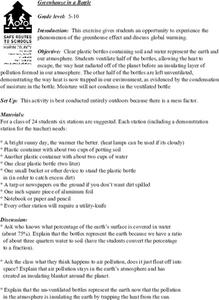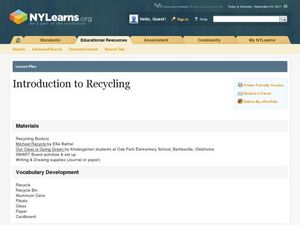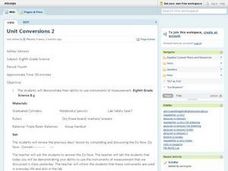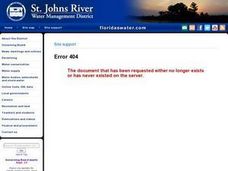Curated OER
Scooting Along!
Students investigate how Newton's Third Law affects vehicle design. In this Newton's Third Law lesson, students use a web site to research Newton, his third law, and how to design a vehicle that uses a balloon for power. They sketch and...
Curated OER
Atomic Structure and Bonding
Eighth graders discuss and write about what led up to the discovery of the atom. Students label proton, nucleus, electron, and neutron in their notes. Students take notes on electron shells and how different atoms have different...
Curated OER
Temperature Scales
Eighth graders explore how to read a thermometer. They convert temperature between Celsius, Fahrenheit and Kelvin. Students explain that Celsius is used in the Scientific community and Fahrenheit is used basically only in the United...
Curated OER
Greenhouse in a Bottle
Students create models of the greenhouse effect using recycled 2-liter bottles. They discuss how their models compares to the real greenhouse effect the earth experiences.
Curated OER
Going Local with Global Warming
Students examine climate change by using recent temperature records. In this data analysis lesson students plot weather data and study the differences between weather and climate.
Curated OER
Just How Thick is Aluminum Foil Anyway???
Students determine the density and thickness of a piece of aluminum foil. In this density and thickness of materials lesson plan, students experimentally find the density of a piece of aluminum foil and compare it to the theoretical...
Curated OER
Tracking Gorillas in the Mist
Students investigate the technologies used in monitoring and tracking the habitat of the mountain gorilla to better explain how technology is being integrated into conservation efforts.
Curated OER
DNA Replication
Students construct a 3-D model of DNA. They demonstrate an awareness of base pairs in written work and in a model. Students model DNA replication using edible materials. They record concluding thoughts in their science notebooks.
Curated OER
Introduction to Recycling
Students read a story about recycling, and then identify 3 different objects that can be recycled on a worksheet of numerous items. In this recycling lesson plan, students also write a sentence about recycling.
It's About Time
Energy from Coal
If plastic is derived from fossil fuels and fossil fuels come from dead dinosaurs, does that mean that plastic dinosaurs are made from real dinosaurs? This lesson goes into depth about coal and other fossil fuels. First the instructor...
Curated OER
Multiplying Polynomials
Investigate polynomial multiplication with the TI-nspire handheld calculator. Using the applications on this calculator, learners explore multiplication of numbers, binomials, a binomial by a polynomial, and polynomials. The dynamic...
Michigan Sea Grant
Fish Habitat and Humans
Strict habitat requirements are needed for the survival of fish populations and fish variety in the Great Lakes. Young scientists become experts in the basic needs of fish and understand how survival necessities can vary with different...
Curated OER
All Wrapped Up
Pupils work in teams to identify and sort types of packaging used in food production. They consider ways to reduce the environmental impact of packaging and reflect how consumer choices play a role in trash production.
Curated OER
Sort Laboratory Practice
Eighth graders sort animals according to certain physical characteristics. In this science lesson, 8th graders explain the reason for such classification. They complete a worksheet individually at the end of the lesson.
Curated OER
Rockin' Map Summaries
Students summarize a piece of text. After reviewing the correct way to read and summarize, students work in groups to summarize a piece of text assigned by the instructor. They write a summary paragraph by creating a story map and the...
Curated OER
Unit Conversions 2
Eighth graders demonstrate the use of instruments of measurement. As a class, they take notes and observe the proper procedure for using a graduated cylinder, a ruler, and a balance/triple beam balance. In groups, 8th graders visit...
Curated OER
Measuring Elapsed Time
Fifth graders convert units within the same measurement system and be able to determine elapsed time. They are given a start time and an end time of a game. Students determine the amount of elapsed time from the data that is given.
Curated OER
Build a Bubble-Powered Rocket
In this law of action and reaction worksheet, students build a bubble powered rocket using a film canister, paper and effervescing tablets to create bubbles inside the canister of the rocket. The pressure inside causes the canister to...
Curated OER
The Day an Egg Solved the Mystery of the Cell
Students conduct an experiment comparing human cells to chicken cells. In this cells lesson plan, students conduct an experiment to see how nutrition moves through cells and how to better take care of their bodies.
Curated OER
Solution Concentration
Students determine differences in concentrations. They have to state the problem they feel exists, consider possible solutions, and develop a plan to come up with for containers whose labels have fallen off. Students base this off the...
Curated OER
Recycle and Respect!
Students explore how they can be a philanthropist. In this recycling instructional activity, students learn what it means to recycle and discuss why items need to be recycled. Students review the term philanthropy and practice this by...
Curated OER
The Earth's Layers: Day 6: Landforms II
Students closely examine the earth's crust and various landforms. In this Earth's layers instructional activity students work in cooperative groups and analyze their roles and responsibilities therein. Each group is assigned a specific...
Curated OER
Arthropod Data Collection
Students describe the life cycle of various bugs as well as their predators and feeding habits. The class participates in a discussion of the various methods scientists use to gather data including research and experiment. After...
Curated OER
More About Water Below the Ground
Students examine groundwater and its relationship to springs, artesian wells, ordinary wells, and sinkholes. They describe the process by which sinkholes are formed. They investigate saltwater contamination and its causes.

























